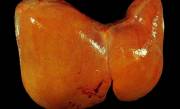 Commentary By: Sandra D'Angelo, PGY-3
Commentary By: Sandra D'Angelo, PGY-3
Nonalcoholic steatohepatitis (NASH) is a disease in which patients have features of alcoholic hepatitis on liver biopsy without a prior history of significant alcohol consumption and negative hepatitis serologies. It is unclear how prevalent this disease is because most patients with liver function abnormalities do not undergo liver biopsy. In those that have had a liver biopsy, the prevalence is estimated to be 7-9%. It is most common in women between the ages of 40-60 and often associated with the metabolic syndrome, obesity, type 2 diabetes mellitus, hyperlipidemia and hypertension. The pathogenesis of NASH has not been clearly defined; most theorize that the initial process is insulin resistance which later leads to hepatic steatosis.
Unfortunately, there is not enough data available to elucidate the natural history of NASH. Approximately 8-26 % of patients with NASH progress to cirrhosis. Most patients with NASH usually have abnormal liver function tests. Ultimately, a liver biopsy is necessary to confirm the diagnosis.
There are few treatment options available that have been proven effective in NASH. Refer to the table below for details. What’s new and exciting is the recent NEJM article entitled, “A Placebo controlled trial of Pioglitazone in subjects with Nonalcoholic Steatohepatitis.” This proof-of-concept study looks at the role of pioglitazone in patients with NASH.
Fifty-five patients with diabetes or impaired glucose tolerance and liver biopsy confirming NASH were randomly assigned to six months of either a hypocaloric diet (a reduction of 500kcal per day in relation to calculated daily intake) plus pioglitazone 45mg daily or a hypocaloric diet plus placebo. In order to assess for a treatment effect, certain variables were analyzed both before and after treatment. These variables included hepatic histologic features, hepatic fat content by means of magnetic resonance spectroscopy, and glucose turnover during an oral glucose tolerance test.
Results showed that those who received pioglitazone had significant metabolic and histologic improvements compared to those who took placebo. Not surprisingly, patients taking pioglitazone had improved glycemic control and glucose tolerance. Interestingly, they also had significant improvements in transaminase levels and decreased hepatic fat content on magnetic resonance spectrospcopy. Inflammation and steatosis were also both significantly improved upon repeat liver biopsy among those taking pioglitazone, however there was no reduction in fibrosis.
This study is promising for the future. As we know, pioglitazone increases hepatic insulin sensitivity and glucose clearance. This addresses the primary problem in NASH which is thought to be insulin resistance. It must be stressed that this was a proof of concept study. It is not surprising that the sample size was small and the results may not be generalized since the patients were such a well-defined group. In addition, the study period was only six months. This could explain why there was not a significant reduction in fibrosis.
This certainly sets the groundwork for a larger and longer study . In addition, one would hope for clearer endpoints, such as improvement in hepatic fibrosis. For the time being, all we can offer is exercise, diet modification and better control of all aspects of the metabolic syndrome.
A Table of Treatments for NASH
References:
A Placebo-Controlled Trial of Pioglitazone in Subjects with Nonalcoholic Steatohepatitis Belfort R., et. al. N Engl J Med 2006; 355:2297-2307, Nov 30, 2006.
image courtesy pathguy.com
